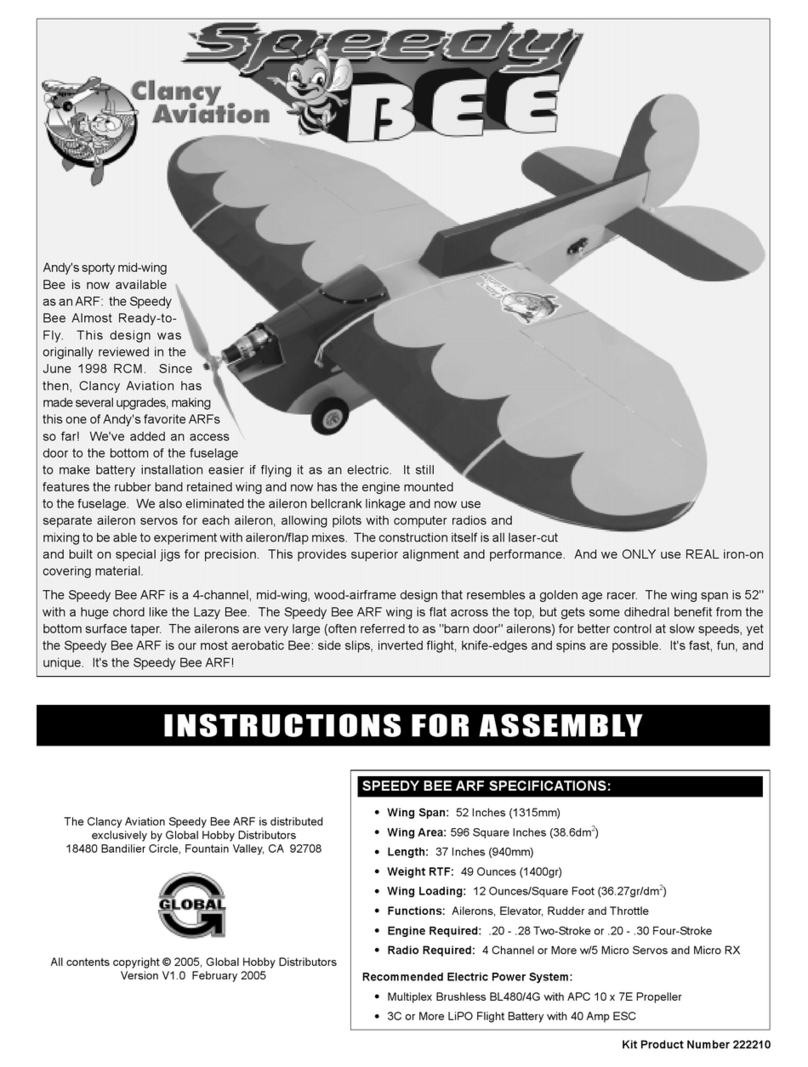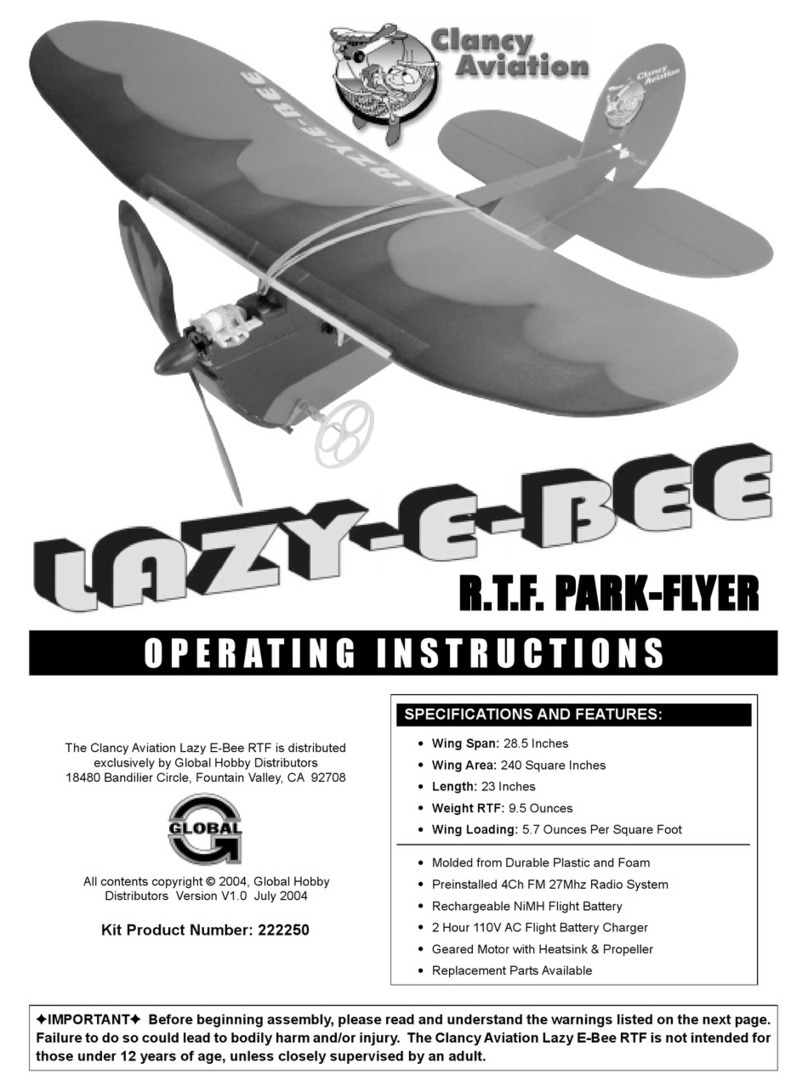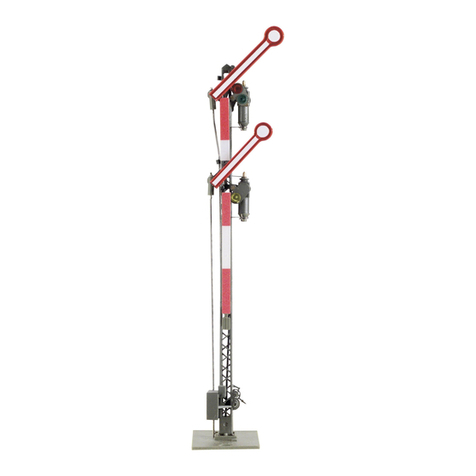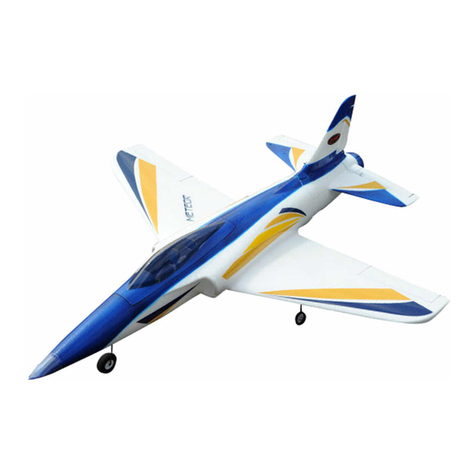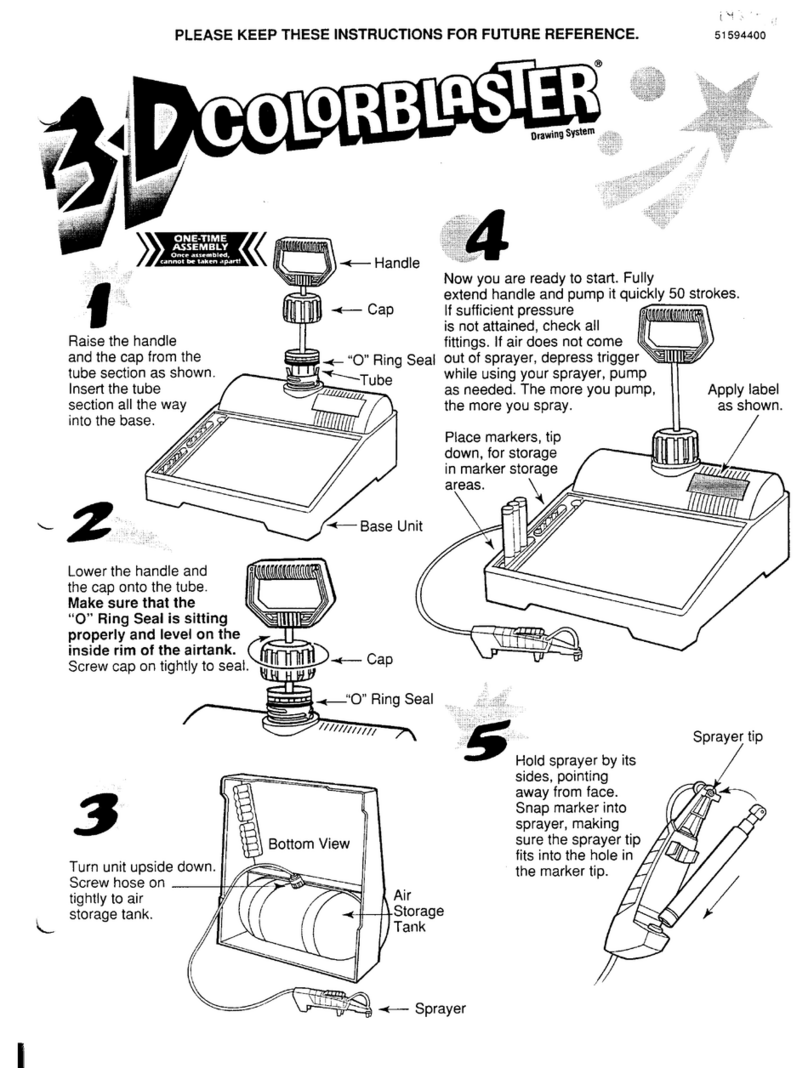Clancy Aviation Big Bee Assembly instructions

1
BIG BEE ARF SPECIFICATIONS:
●Wing Span: 60 Inches (1524mm)
●Wing Area: 1150 Square Inches (74dm2)
●Length: 48.75 Inches (1238mm)
●Weight RTF: 5.25 - 6 Pounds (148 - 178gr)
●Wing Loading: 10.5 - 12 Ounces/Square Foot (2 - 2.3gr/dm2)
●Functions: Ailerons, Elevator, Rudder and Throttle
●Engine Required: .32 - .46 Two-Stroke or .40 - .61 Four-Stroke
●Radio Required: 4 Channel or More w/5 Standard Servos
Recommended Electric Power Systems:
●Astro Flight Cobalt 25 Geared, AXI 2826/10 or Similar with Matching ESC
●12-16 Cell NiMH Sub-C or 3-4 Cell 2100-3200mAH LiPO
INSTRUCTIONS FOR ASSEMBLY
Kit Product Number 222212
The Clancy Aviation Big Bee ARF is distributed
exclusively by Global Hobby Distributors
18480 Bandilier Circle, Fountain Valley, CA 92708
All contents copyright © 2005, Global Hobby Distributors
Version 2.0 June 2005
Clancy Aviation has brought the world of the Classic Lazy Bee to new dimensions with this 60" wing span, .40 size engine Big Bee
ARF. Get to the field quickly with this low parts-count, easy-to-assemble aircraft. Flying the Lazy Bee is fun-defined and the Big
Bee ARF brings a new dimension to that style. The poly-tips capture the unique styling and handling of the Lazy Bee but with an
added flair of ailerons for smoother control response. Use them together and you'll find this Bee will perform mild-to-wild
gyrations you only thought possible with fun-fly aircraft. Unique too to the Big Bee ARF is its park flyer-like wing loading. At only
10.5 ounces per square foot and 1150 square inches, it's amazing what the Big Bee ARF can do.
The Lazy Bee flying experience is a unique one, and with the larger Big Bee ARF, you'll find new fun in this special Andy
Clancy design.

2
TABLE OF CONTENTS
This R/C airplane is not a toy! If misused or abused, it can cause serious bodily injury and/or damage to property. Fly only in open
areas and preferably at a dedicated R/C flying site. We suggest having a qualified instructor carefully inspect your airplane before
its first flight. Please carefully read and follow all instructions included with this airplane, your radio control system and any other
components purchased separately.
OUR GUARANTEE
Clancy Aviation guarantees this kit to be free from defects in both material and workmanship at the date of purchase. This does not cover
any component parts damaged by use, misuse or modification. In no case shall Clancy Aviation's liability exceed the original cost of
the purchased kit.
In that Clancy Aviation has no control over the final assembly or material used for final assembly, no liability shall be assumed for any damage
resulting from the use by the user of the final user-assembled product. By the act of using the final user-assembled product, the user accepts all
resulting liability.
FOR YOUR INFORMATION
To make your modeling experience totally enjoyable, we recommend that you get experienced, knowledgeable help with assembly and during
your first flights. Your local hobby shop has information about flying clubs in your area whose membership includes qualified instructors. If there
is no hobby shop in your area, we recommend that you contact the AMA at the address below. They will be able to help you locate a flying field
near you.
Academy of Model Aeronautics
5151 East Memorial Drive
Muncie IN 47302-9252
(800) 435-9262
www.modelaircraft.org
SAFETY WARNING
Check out our website for more information on
this and other exciting Clancy Aviation products!
http://clancyaviation.globalhobby.com
Safety Warning ...................................................................................... 2
Introduction ............................................................................................ 3
Customer Service Information .............................................................. 3
Section 1: Our Recommendations ....................................................... 4
Section 2: Tools and Supplies Required ............................................. 5
Section 3: A Note About Covering ....................................................... 5
Section 4: Kit Contents ........................................................................ 6
Section 5: Wing Assembly ................................................................... 7
Section 6: Aileron Hinging ................................................................. 10
Section 7: Wing Mounting .................................................................. 11
Section 8: Stabilizer Installation ......................................................... 12
Section 9: Rudder Installation ............................................................ 16
Section 10: Landing Gear Installation ................................................ 17
Section 11: Engine Installation .......................................................... 19
Section 12: Fuel Tank Assembly and Installation .............................. 22
Section 13: Throttle Control System Installation ............................... 23
Section 14: Elevator and Rudder Control Systems Installation ........... 25
Section 15: Aileron Control System Installation ................................ 28
Section 16: Final Assembly ................................................................ 30
Section 17: Balancing the Big Bee ARF ............................................ 33
Section 18: Lateral Balancing the Big Bee ARF ............................... 33
Section 19: Control Throws ................................................................ 34
Section 20: Replacement Parts ......................................................... 34
Product Evaluation Sheet ................................................................... 35

3
Thank you for purchasing the Clancy Aviation Big Bee ARF. Before completing the final assembly of your new airplane,
please carefully read through this instruction manual in its entirety. Doing so will ensure your success the first time
around!
BIG BEE ARF FEATURES
●Prebuilt from High-Quality Balsa and Light Plywood
●Detailed, Laser-Cut Parts to Maximize Weight Reduction and Precovered with Real Iron-On, Heat-Shrink Covering Material
●Easy-to-Install Molded Clear Windshield and Side Windows
●Can be Flown with Glow Power or Electric Power - Accepts a Wide Range of Powerplants
●Durable Shock-Absorbing Main Landing Gear with Steerable Tail Wheel
●Dual Aileron Servos for Crisp Roll Response
●Includes a High-Quality Hardware Package
●Fast and Easy Assembly - Over 60 High-Resolution Digital Photos and Drawings to Guide You
This instruction manual is designed to guide you through the entire assembly process of your new airplane in the least amount of
time possible. Along the way you'll learn how to properly assemble your new airplane and also learn tips that will help you in the
future. We have listed some of our recommendations below. Please read through them before beginning assembly.
●Please read through each step before beginning assembly.
You should find the layout very complete and straightforward.
Our goal is to guide you through assembly without any of the
headaches and hassles that you might expect.
●There are check boxes next to each procedure. After you
complete a procedure, check off the box. This will help prevent
you from losing your place.
●Cover your work table with brown paper or a soft cloth, both
to protect the table and to protect the parts.
●Keep a couple of small bowls or jars handy to put the small
parts in after you open the accessory bags.
●We're all excited to get a new airplane in the air, but take your
time. This will ensure you build a straight, strong and great
flying airplane.
●If you come across this symbol ☞, it means that this is an
important point or an assembly hint.
If you should find a part missing or damaged, or have any questions about assembly, please contact us at the address below:
To enable us to better serve your needs, please include your email address with any correspondence you send to us. Your email
address will be added to our Customer Service Database so you will automatically receive free updates and tech notices for your
particular product. You will also receive repair status updates (if applicable) and other important information about your product
as it becomes available.
IMPORTANT INFORMATION ABOUT YOUR EMAIL ADDRESS
INTRODUCTION
CHECK IT OUT! We urge you to come check out our website at http://globalservices.globalhobby.com. There you will find public message
boards frequented by other Clancy Aviation product owners and the Global Services support staff. This is a great place to learn about new
products, get help and suggestions for your product or just simply hang out and chat with people that share your same interests.
Global Hobby Distributors will not disclose the information it collects to outside parties. Global Hobby Distributors
does not sell, trade, or rent your personal information to others . Your privacy is important to us.
CUSTOMER SERVICE INFORMATION
Global Services
18480 Bandilier Circle
Fountain Valley, CA 92708
Phone: (714) 963-0329
Fax: (714) 964-6236
Email: service@globalhobby.net

4
This section describes our recommendations to help you in deciding which types of accessories to purchase for your new
Clancy Aviation Big Bee ARF.
Please read through this entire section very carefully. We have provided you with tips and recommendations that, if
followed, will result in a great flying airplane. Failure to follow our recommendations may result in a poor flying airplane.
SECTION 1: OUR RECOMMENDATIONS
What Engine Should I Use?
What Radio System and Servos Should I Use?
You will need to use a four or more channel radio control system with five standard servos. A
standard four-channel radio or a more sophisticated computer radio would work equally well. Using
a computer radio will allow you to plug each aileron servo separately into the receiver, allowing you
the capability of aileron to flap mixing for outrageous control response. Note that in order to take
advantage of aileron to flap mixing, you will need to use a six or more channel receiver.
What Else Do I Need?
There really isn't much else that you'll need to finish the airplane. Most of the hardware is included in the kit, so
about the only thing else you'll need is a propeller and glow plug to suit your engine, two servo extension leads
and a Y-Harness (if you're not using mixing). You'll also need typical modeling supplies, such as foam rubber to
protect your receiver and battery, and fuel tubing. You may need a soldering iron, solder and other related
supplies if you're using electric power.
Suggested Setup for Electric Flight
We know that many customers will want to power their Speedy Bee ARF with an electric power
system, rather than a glow engine. A number of different power systems will work equally well.
We suggest using either the Astro Cobalt 25 geared motor, the AXI 2826/10, or any motor of
similar output. For batteries, a 12-16 cell pack of Sub-C NiMH cells will work well, or for longer
run-time and less weight, use a 3-4 cell 2100-3200mAH LiPO battery. The ESC you choose should match the motor, propeller and
flight battery type and cell count you chosen.
QTY. 1 210756 Magnum XLS .46A Two-Stroke Engine
QTY. 1 608560 APC 11 x 6 Composite Propeller
QTY. 5 444104 Cirrus CS-36 Standard Servos
QTY. 2 444713 Cirrus 12" Servo Extensions
QTY. 1 444728 Cirrus Y-Harness
QTY. 1 115559 Thunderbolt # 3 Performance Glow Plug
QTY. 1 115923 Global XX Silicone Fuel Tubing
QTY. 1 868638 Dubro 1/4" Protective Foam Rubber
QTY. 1 867903 Dubro 3/8" Heat-Shrink Tubing
Here's a List of What We Used to Finish Our Big Bee ARF
✦✦
✦✦
✦IMPORTANT✦✦
✦✦
✦The part number for the Cirrus servos is compatible with all name-brand radio control systems. These servos use a universal
connector. The part number for the Cirrus servo extensions and Y-Harness are compatible with Hitec and JR radio control systems. These items
are also available with connectors that are compatible with Futaba and Airtronics radio control systems.
The Big Bee ARF is designed to use a .32 - .46 size two-stroke engine or a .40 - .61 size four-stroke engine.
The airplane flies great using engines within the recommended size ranges, although for the
most speed and best aerobatic performance we suggest using an engine at the upper end of
the size range. For smooth and relaxing slow flight, use an engine in the low end of the
size range.
We don't suggest using engine's larger than those recommended. A larger engine will
typically weigh more and this extra weight could have a negative effect on the airplane's flight characteristics.
A larger engine may also be physically too big to mount onto the firewall.
IF YOU'RE FLYING AT HIGHER ALTITUDES, WE RECOMMEND USING AN ENGINE AT THE HIGH END OF THE RECOMMENDED SIZE RANGE.

5
❑Kwik Bond Thin C/A # 887500
❑Kwik Bond Thick C/A # 887510
❑Kwik Bond 5 Minute Epoxy # 887560
❑Kwik Bond 30 Minute Epoxy # 887565
❑Kwik Bond C/A Debonder # 887545
❑Pacer Formula 560 Canopy Glue # 339176
❑Pacer Z-42 Blue Threadlocker # 339162
❑Wilhold Silicon Sealant # 335407
❑# 0, #1 & #2 Phillips Head Screwdrivers
❑2.5mm Hex Wrench
❑Wire Cutters
❑Needle Nose Pliers
❑Adjustable Wrench
❑Excel Modeling Knife # 692801
❑Scissors
❑Electric Drill
The covering material used on the Clancy Aviation Big Bee ARF is real iron-on, heat-shrink covering material. It is possible with heat
and humidity changes that the covering on your airplane may wrinkle or sag. This trait is inherent in all types of heat-shrink material.
To remove any wrinkles that might be visible you will need to use a heat-sealing covering iron.
Follow this simple procedure to remove the wrinkles:
❑Plug in and turn on the sealing iron to the medium-high temperature setting. Allow the sealing iron to heat up for approximately
5 - 7 minutes.
❑After the sealing iron has reached temperature, lightly apply the sealing iron to the wrinkled section of the covering. Move the
sealing iron slowly over the wrinkled section until the covering tightens and the wrinkles disappear.
☞If the color layer smears from any of the seams the temperature of the sealing iron is too hot. Turn the temperature dial down
and wait about 5 minutes for the sealing iron to adjust to the lower temperature. You can remove any excess color streaks using a
paper towel soaked with a small quantity of Acetone.
We do not suggest storing your airplane in an extremely hot environment (like the back of your car in direct sunlight)
for any length of time. The extreme heat could cause the covering material to wrinkle and possibly distort the molded windshield and
side windows. The extreme heat could also damage the fragile components of the radio control system.
SECTION 2: TOOLS AND SUPPLIES REQUIRED
The tools and supplies listed below will be necessary to finish the assembly of your new Clancy Aviation Speedy Bee ARF. We
suggest having these items on hand before beginning assembly.
SECTION 3: A NOTE ABOUT COVERING
PRO TIP
❑Assorted Drill Bits
❑Ernst Airplane Stand # 223977
❑Ruler
❑Pencil
❑Dubro T-Pins # 567677
❑Builder's Triangle
❑220 Grit Sandpaper w/Sanding Block
❑Masking Tape
❑Paper Towels
❑Wax Paper
❑Petroleum Jelly
❑Rubbing Alcohol
❑NHP Epoxy Mixing Sticks # 864204
❑NHP Epoxy Mixing Cups # 864205
❑Global Heat Gun # 360920
❑Global Heat-Sealing Iron # 360900

6
We have organized the parts as they come out of the box for easier identification during assembly. Before you begin assembly,
group the parts as we list them below. This will ensure that you have all of the parts before you begin assembly and it will also help
you become familiar with each part.
If you find any parts missing or damaged, please contact us as soon as possible, using the Customer Service
Information on page # 3. A complete replacement parts list can be found on page # 33.
SECTION 4: KIT CONTENTS
AIRFRAME ASSEMBLIES
❑(1) Fuselage w/Hatch Cover
❑(1) Wing Center-Section Panel
❑(1) Right Wing Tip Panel w/Aileron
❑(1) Left Wing Tip Panel w/Aileron
❑(1) Horizontal Stabilizer w/Elevator
❑(1) Rudder
LANDING GEAR ASSEMBLY
❑(2) Main Gear Wheels
❑(1) Aluminum Axle Support Tube
❑(1) Steel Axle
❑(2) Nylon Spacers
❑(2) Wheel Collars
❑(2) M3 x 5mm Machine Screws
❑(2) Rubber Bands
AILERON CONTROL SYSTEM
❑(2) 3-1/2" Threaded Wires w/90º Bend
❑(2) Nylon Control Horns (Large)
❑(4) M2 x 10mm Wood Screws
❑(2) Nylon Clevises
❑(2) Nylon 90º Snap-Keepers
❑(6) Steel-Pinned Hinges
ELEVATOR CONTROL SYSTEM
❑(1) 18-3/8" Threaded Wire w/90º Bend
❑(1) 17-7/8" Threaded Wire w/90º Bend
❑(2) Nylon Control Horns w/Backplates (Small)
❑(2) Nylon Clevises
❑(2) Nylon 90º Snap-Keepers
❑(4) M2 x 12mm Machine Screws
❑(8) C/A-Style Hinges (7 Large and 1 Small)
ENGINE MOUNT ASSEMBLY
❑(2) Engine Mounting Beams
❑(4) M3 x 20mm Socket-Cap Screws
❑(4) M3 x 25mm Socket-Cap Screws
❑(4) M3 Lock Nuts
❑(4) M3 Blind Nuts
❑(12) M3 Flat Washers
❑(1) Prebent Tail Wheel Wire w/Nylon Bearing
❑(1) Tail Wheel
❑(1) Nylon Spacer
❑(1) Wheel Collar
❑(1) M3 x 5mm Machine Screw
TAIL WHEEL ASSEMBLY
❑(1) 21-1/2" Plain Wire w/Z-Bend
❑(1) Adjustable Pushrod Connector w/Machine Screw & Nut
THROTTLE CONTROL SYSTEM
❑(1) 240cc Fuel Tank
❑(1) Large Diameter Metal Plate
❑(1) Small Diameter Metal Plate
❑(1) Neck-Reinforcement Ring
❑(1) Rubber Stopper
❑(1) Fuel Pick-Up "Clunk"
❑(1) M3 x 20mm Machine Screw
❑(1) Silicone Fuel Tubing
❑(3) Aluminum Tubing
FUEL TANK ASSEMBLY
MISCELLANEOUS FUSELAGE PARTS
❑(1) Clear Molded Windshield
❑(2) Clear Molded Side Window Sets
❑(3) M2 x 10mm Flange-Head Wood Screws
❑(1) Clear Tubing
❑(1) Decal Set
MISCELLANEOUS WING PARTS
❑(1) Plywood Wing Mounting Bracket
❑(2) Aluminum Wing Joiners
❑(1) Plywood Wing-Screw Doubler (W35)
❑(2) M4 x 25mm Machine Screws
❑(2) M4 Flat Washers

7
SECTION 5: WING ASSEMBLY
STEP 1: ALIGNING THE WING PANELS
❑Using a modeling knife, cut away and remove the excess covering
material that overlaps onto the root ribs of each wing tip panel, leaving
about 1/16" overlapped so it does not pull away. Do the same to
remove the covering material from only the gluing surfaces on each
root end of the wing center-section panel.
✦✦
✦✦
✦IMPORTANT✦✦
✦✦
✦It's very important to the integrity of the glue joints
that you remove as much covering material from the root ribs as
possible. Do not omit this procedure or the glue joints may fail
during flight.
❑Working with one aluminum wing joiner for now, use a ruler and a
pencil to locate and draw a vertical centerline on each side of one
aluminum wing joiner.
❑Test-fit the aluminum wing joiner into the wing joiner box in one wing
tip panel. It should slide easily into the joiner box up to the centerline
you drew.
☞If the wing joiner does not fit properly, use 220 grit sandpaper
with a sanding block to lightly deburr the edges and tips of the
wing joiner.
❑Kwik Bond 30 Minute Epoxy
❑Excel Modeling Knife
❑Ruler
❑Pencil
❑220 Grit Sandpaper w/Sanding Block
❑(1) Wing Center-Section Panel
❑(1) Right Wing Tip Panel w/Aileron
❑(1) Left Wing Tip Panel w/Aileron
❑(1) Plywood Wing Mounting Bracket
❑(2) Aluminum Wing Joiners
❑Masking Tape
❑Paper Towels
❑Rubbing Alcohol
❑NHP Epoxy Mixing Sticks
❑NHP Epoxy Mixing Cups
YOU'LL NEED THE FOLLOWING PARTS FROM THE KIT:
YOU'LL NEED THE FOLLOWING TOOLS AND SUPPLIES:
Continued On Next Page
☛☛
☛☛
☛
❑Remove the aileron and hinges from both wing tip panels and set them aside for now.
✦✦
✦✦
✦IMPORTANT✦✦
✦✦
✦The aluminum wing joiner is straight. There is no top or bottom.

8
❑Carefully slide the wing tip panel and the wing center-section panel
together with the wing joiner temporarily installed (without using glue).
✦✦
✦✦
✦IMPORTANT✦✦
✦✦
✦While sliding the two wing panels together, carefully
guide the aileron servo lead pull-string from the hole in the wing
center-section panel into the matching hole in the wing tip panel.
✦✦
✦✦
✦IMPORTANT✦✦
✦✦
✦When the wing joiner is installed, it should not fit tightly into the wing panels. It should actually be slightly
loose. This will ensure that when you glue the wing joiner into place that epoxy can get into the joints between the wing joiner
and the wing joiner boxes. If the wing joiner fits too tightly, the epoxy will be pushed out of the joints when you slide the wing
joiner into the wing panels, leaving no glue to secure it into place.
❑While holding the wing tip panel and the wing center-section panel together firmly, make sure that both wing panels are lined up
at both the leading and the trailing edges, then look carefully at the glue joint: the wing panels should fit together tightly with few or
no gaps in the joint.
✦✦
✦✦
✦IMPORTANT✦✦
✦✦
✦The proper amount of dihedral is built into the root rib of the wing tip panel. It's important that the two wing
panels fit together firmly to ensure that the amount of dihedral is correct.
☞If the wing panels do not fit together properly, remove the wing joiner and use 220 grit sandpaper with a sanding block to
lightly sand the edges and tips of the wing joiner, until you are satisfied with the fit. Typically, the fit of these parts is very good,
although, to achieve a perfect fit, you may need to sand the root end of one or both of the wing panels, in addition to lightly sanding
the edges and tips of the wing joiner.
❑When satisfied with the fit, remove the wing tip panel from the wing center-section panel.
STEP 2: INSTALLING THE WING TIP PANEL
❑Apply a long strip of masking tape to the top and bottom edges of the
root rib on both the wing panels.
☞The masking tape will prevent excess epoxy from getting onto the
parts when you join them. This will make cleanup of the glue joint
much easier.
❑Mix a generous amount of 30 minute epoxy. Working with the wing tip panel for now, apply a thin layer of epoxy inside the wing
joiner box and to only half of the wing joiner. Make sure to cover the top and bottom, as well as the sides, and use enough epoxy to
fill any gaps.
✦✦
✦✦
✦WARNING✦✦
✦✦
✦Use only 30 or 45 minute epoxy to install the wing joiner and to join the wing panels together. Do not use 5
minute epoxy. It is not strong enough.
❑Slide the wing joiner into the wing tip panel up to its centerline. Quickly remove any excess epoxy, using a paper towel and
rubbing alcohol, and allow the epoxy to set up before proceeding.
❑After the epoxy has set up, test-fit the wing tip panel and the wing center-section panel together again to double-check that they
still fit together properly. Check the leading and trailing edges, too. It's important that they be even with each other.
Continued On Next Page
☛☛
☛☛
☛

9
❑Mix a generous amount of 30 minute epoxy and apply a thin layer to the exposed half of the wing joiner, the inside of the wing
joiner box in the wing center-section panel, and to the entire gluing surface of BOTH root ribs. Make sure to use enough epoxy
to fill any gaps.
✦✦
✦✦
✦IMPORTANT✦✦
✦✦
✦It is of the utmost importance to the integrity of the glue joint that you apply a generous amount of epoxy to both
root ribs and to the wing joiner. Not using enough epoxy can result in wing failure during flight.
❑Slide the two wing panels together and realign them. Quickly wipe away any excess epoxy, using a paper towel and rubbing
alcohol, and use pieces of masking tape to hold the two wing panels aligned until the epoxy fully cures.
STEP 3: CHECKING THE GLUE JOINT
❑Once the epoxy has fully cured, remove the masking tape and double-check the glue joint. If any gaps are present, mix a small
quantity of 30 minute epoxy and carefully fill any remaining gaps. Quickly remove any excess epoxy, using a paper towel and
rubbing alcohol, and allow the epoxy to thoroughly cure.
✦✦
✦✦
✦IMPORTANT✦✦
✦✦
✦Do not omit this procedure. The parts should fit together tightly, but it's possible to have some small gaps that
appear after the epoxy has cured. To make the glue joint as strong as possible, it's important to fill any gaps, using 30
minute epoxy.
❑After the epoxy has fully cured, repeat the previous steps and procedures to install the second wing tip panel onto the other end
of the wing center-section panel.
STEP 4: INSTALLING THE WING MOUNTING BRACKET
❑Using a modeling knife, cut away and remove the covering material
from over the wing mounting bracket slot in the bottom of the wing. The
slot is located on the centerline of the wing, 2-1/4" behind the leading
edge. The slot is 3-7/8" long and 1/4" wide.
❑Test-fit the plywood wing mounting bracket into the slot, as shown.
When positioned properly, the wing mounting bracket should be pushed
forward as far as possible and the back edge of the wing mounting bracket
should be even with the surface of the wing.
✦✦
✦✦
✦IMPORTANT✦✦
✦✦
✦The notch in the front of the wing mounting bracket hooks under the sheeting on the bottom of the wing. There
will be a gap between the back of the wing mounting bracket and the back of the mounting slot. This is normal.
❑When satisfied with the fit and alignment, glue the wing mounting bracket into place, using a generous amount of 30 minute
epoxy. Remove any excess epoxy, using a paper towel and rubbing alcohol, and allow the epoxy to fully cure.

10
❑Kwik Bond 5 Minute Epoxy
❑Excel Modeling Knife
❑220 Grit Sandpaper w/Sanding Block
❑Paper Towels
❑(6) Steel-Pinned Hinges
❑Rubbing Alcohol
❑Petroleum Jelly
❑NHP Epoxy Mixing Sticks
❑NHP Epoxy Mixing Cups
YOU'LL NEED THE FOLLOWING PARTS FROM THE KIT:
YOU'LL NEED THE FOLLOWING TOOLS AND SUPPLIES:
SECTION 6: AILERON HINGING
STEP 1: HINGING THE AILERONS
✦✦
✦✦
✦Important Information About the Aileron Hinges Included with Your Big Bee ARF✦✦
✦✦
✦
The hinges are not glued into place from the factory. You must glue them into place. The ailerons are hinged using plastic steel-
pinned hinges that are designed to be glued into place with epoxy. Do not use thin C/A to glue these hinges into place.
For flutter-free control surfaces and crisp control response, it is imperative that the hinges be glued in properly. This is achieved
by having a tight hinge gap (no more than 1/32" wide) and using plenty of glue.
❑Using 220 grit sandpaper with a sanding block, lightly sand both sides
of the mounting tabs on each of the eight hinges, to roughen the smooth
plastic surfaces.
✦✦
✦✦
✦IMPORTANT✦✦
✦✦
✦You must roughen the plastic so that the epoxy will
stick to it. If you don't roughen the plastic, the hinge(s) may pull out
during flight.
❑Slide three of the hinges into one aileron and center them in the
middle of the hinge slots.
❑Using a modeling knife, carefully cut a shallow bevel in the aileron
directly above and below each hinge, so that the hinge pivot point can
be recessed into the leading edge.
✦✦
✦✦
✦IMPORTANT✦✦
✦✦
✦The bevel should be deep enough so that when
you push the hinge in further, the pivot point of the hinge will be
flush with the leading edge of the aileron. This will ensure that there
will be little to no hinge gap when the aileron is hinged to the wing.
Continued On Next Page
☛☛
☛☛
☛

11 Continued On Next Page
☛☛
☛☛
☛
❑When satisfied with the fit and alignment, remove the hinges and carefully apply a thin coat of lightweight oil or petroleum jelly to
only the pivot point of each of the three hinges. This will prevent the hinges from being glued solid when you install them.
❑Mix a small quantity of 5 minute epoxy and carefully glue each of the three hinges into only the aileron for now. Make sure that
the hinges' pivot point is straight and flush with the leading edge of the aileron, then remove any excess epoxy, using a paper towel
and rubbing alcohol. Allow the epoxy to set up for about 10 minutes before proceeding.
❑After the epoxy has set up, test-fit the aileron to the wing panel,
making sure that the leading edge of the aileron is pushed firmly up
against the trailing edge of the wing panel, and that the tip of the aileron
is even with the tip of the wing. There should be no more than a 1/32"
wide hinge gap. There should be a narrow gap between the inboard
edge of the aileron and the wing.
☞If you can't push the aileron far enough forward to achieve the proper
hinge gap, you will need to cut a shallow bevel in the trailing edge of the
wing for each of the hinges.
❑When satisfied with the fit, remove the aileron and apply another coat of lightweight oil or petroleum jelly to each hinge pivot
point, then hinge the aileron to the wing, using 5 minute epoxy. Remove any excess epoxy, using a paper towel and rubbing alcohol,
and allow the epoxy to set up before proceeding.
❑After the epoxy sets up, pivot the aileron up and down several times to free up the hinges. If you notice any excess dried epoxy
on any hinge pivot point, it can be removed by carefully using the tip of your modeling knife to cut it away.
❑Repeat the previous procedures to hinge the aileron to the other half of the wing, then pull firmly on each aileron to double-check
that the hinges hold securely.
❑Kwik Bond 5 Minute Epoxy
❑# 2 Phillips Head Screwdriver
❑Excel Modeling Knife
❑Ruler
❑Pencil
❑(1) Fuselage w/Hatch Covers
❑(1) Plywood Wing-Screw Doubler (W35)
❑(2) M4 x 25mm Machine Screws
❑(2) M4 Flat Washers
❑Paper Towels
❑Rubbing Alcohol
❑NHP Epoxy Mixing Sticks
❑NHP Epoxy Mixing Cups
YOU'LL NEED THE FOLLOWING PARTS FROM THE KIT:
YOU'LL NEED THE FOLLOWING TOOLS AND SUPPLIES:
SECTION 7: WING MOUNTING
STEP 1: INSTALLING THE WING-SCREW DOUBLER
❑Using a modeling knife, cut away and remove the covering material
from over the top and bottom of the two predrilled wing-screw mounting
holes in the wing. The holes are located 3/4" out from the centerline of
the wing and 1" in front of the trailing edge.
❑Using a modeling knife, cut away and remove the covering material
from over the two predrilled holes in the plywood wing-screw doubler, too.

12
❑Place the wing onto the wing saddle, push it forward completely,
then push the trailing edge down into place.
☞Make sure that the tab in the wing mounting bracket tab fully
engages the notch in the front of the fuselage.
❑Align the holes in the wing with the preinstalled blind nuts in the wing
mounting block inside the fuselage.
❑Secure the wing into place, using two M4 x 25mm machine screws
and two M4 flat washers.
❑(6) C/A-Style Hinges (Large)
❑Ruler
❑Pencil
❑220 Grit Sandpaper w/Sanding Block
❑Paper Towels
❑NHP Epoxy Mixing Sticks
❑NHP Epoxy Mixing Cups
YOU'LL NEED THE FOLLOWING PARTS FROM THE KIT:
YOU'LL NEED THE FOLLOWING TOOLS AND SUPPLIES:
SECTION 8: STABILIZER INSTALLATION
Continued On Next Page
☛☛
☛☛
☛
✦✦
✦✦
✦IMPORTANT✦✦
✦✦
✦Don't overtighten the screws. You don't want to crush the wing.
✦✦
✦✦
✦IMPORTANT✦✦
✦✦
✦Before gluing the wing-screw doubler into place in
the next procedure, make sure to cut away and remove the covering
material from the wing where the wing-screw doubler will be glued
into place. This will ensure a strong glue joint.
❑Glue the wing-screw doubler to the top of the wing, using a thin layer
of 5 minute epoxy. When aligned properly, the predrilled holes in the
wing-screw doubler should line up with the predrilled holes in the wing
and the back of the wing-screw doubler should be even with the trailing
edge of the wing.
STEP 2: MOUNTING THE WING
❑Using a modeling knife, cut away and remove the covering material
from over the two predrilled wing-screw mounting holes in the top of the
fuselage. The holes are located 5/8" behind the wing saddle opening
and 7/8" in from the fuselage sides.
❑Using a modeling knife, cut away and remove the covering material from over the precut notch in the forward bulkhead for the tab
in the plywood wing mounting bracket.
❑Kwik Bond 30 Minute Epoxy
❑Kwik Bond Thin C/A
❑Kwik Bond C/A Debonder
❑Excel Modeling Knife
❑Dubro T-Pins
❑Ernst Airplane Stand
❑(1) Horizontal Stabilizer w/Elevator

13 Continued On Next Page
☛☛
☛☛
☛
STEP 1: ALIGNING THE HORIZONTAL STABILIZER
❑Using a modeling knife, cut away and remove the covering material
from over the stabilizer mounting slot in each side of the fuselage.
The slot is located 3" below the top of the fuselage and is 4" long and
3/16" wide.
❑Using a ruler and a pencil, locate and draw a centerline mark on the
trailing edge of the stabilizer.
❑Slide the stabilizer into the mounting slot and temporarily align it.
The stabilizer should be pushed forward as far as possible and the
centerline mark you drew on the stabilizer should be lined up with the
centerline of the fuselage.
❑When satisfied with the alignment, hold only the trailing edge of the
stabilizer in position using a T-Pin.
✦✦
✦✦
✦IMPORTANT✦✦
✦✦
✦The front of the stabilizer should be able to pivot from side to side and the back should stay firmly in place and
aligned. The trailing edge should not be allowed to move from side to side.
❑Install the wing onto the fuselage and secure it into place.
❑Use a ruler to carefully measure the distance between the tips of
the stabilizer assembly and the tips of the wing. Pivot the stabilizer
assembly until both of these measurements are equal. When both
measurements are equal, the stabilizer is square to the wing.
☞When both of these measurements are equal, you're assured that the stabilizer is square to the wing.

14
❑When you're satisfied that the stabilizer is square to the wing, use a
pencil to draw a mark on each side of the front of the stabilizer where
it and the fuselage sides meet, then use a T-Pin to hold the stabilizer
firmly in place and aligned.
❑With the stabilizer held firmly in place, look from the front of the
airplane at both the wing and the stabilizer. When aligned properly, the
stabilizer should be parallel to the wing.
☞If the stabilizer is not parallel to the wing, remove it and use 220 grit sandpaper with a sanding block to sand down the higher
side of the stabilizer mounting slot, then reinstall the stabilizer and check the alignment once more. Repeat this procedure until
you are satisfied with the alignment.
C=C-1
❑When satisfied with the alignment, use a pencil to draw a line on
each side of the stabilizer where it meets the fuselage sides. Do this on
both the top and the bottom.
❑Remove the stabilizer from the fuselage and use a modeling knife to
carefully cut away and remove the covering material from between the
lines you drew. Do this on both the top and the bottom.
✦✦
✦✦
✦WARNING✦✦
✦✦
✦When cutting through the covering to remove it, cut
with only enough pressure to cut through only the covering itself.
Cutting down into the balsa structure could weaken the stabilizer and
cause it to fail during flight.
❑Mix a generous amount of 30 minute epoxy and carefully apply a thin layer to the top and bottom of the gluing surfaces of the
stabilizer, and to the gluing surfaces of the stabilizer mounting slot.
❑Slide the stabilizer back into place and realign it, double-checking all of your measurements once more before the epoxy
sets up. Quickly remove any excess epoxy, using a paper towel and rubbing alcohol, and use T-Pins to hold the stabilizer in place
and aligned until the epoxy has fully cured.
STEP 2: MOUNTING THE HORIZONTAL STABILIZER
Continued On Next Page
☛☛
☛☛
☛

15
☞Remove any C/A that may run down the hinge line, using C/A Debonder.
❑Allow the C/A to dry for about 15 minutes, then pivot the elevator up and down several times to free up the hinges.
✦✦
✦✦
✦IMPORTANT✦✦
✦✦
✦After the C/A has fully cured, gently grasp the elevator and stabilizer and pull on the elevator like you are trying
to pull out the hinges. If one or more hinges feels loose, apply more C/A to the hinge(s) and allow it to completely cure.
STEP 3: HINGING THE ELEVATOR
❑Push two T-pins through the center of six large C/A-style elevator
hinges, as shown.
✦✦
✦✦
✦IMPORTANT✦✦
✦✦
✦The T-pins will keep the hinges centered while you
are hinging the elevator.
☞The elevator is hinged using six large C/A-style hinges.
✦✦
✦✦
✦Important Information About the C/A-Style Hinges Included with Your Big Bee ARF✦✦
✦✦
✦
The hinges are not glued into place from the factory. You must glue them into place.
The elevator and rudder are hinged using C/A-style hinges. These hinges are designed to be glued into place using thin C/A. Do
not glue these hinges into place using any other type of glue, such as thick C/A or epoxy.
For flutter-free control surfaces and crisp control response, it is imperative that the hinges be glued in properly. This is achieved
by having a tight hinge gap (no more than 1/32" wide) and using plenty of glue.
❑Push the elevator and its hinges into the hinge slots in the trailing edge of the stabilizer. The elevator should be pushed firmly up
against the trailing edge, so that there is a minimal hinge gap (no more than 1/32"), and the tips of the elevator should be even with
the tips of the stabilizer.
❑Slide one hinge into each hinge slot, making sure that you push
each hinge in up to the T-pins. Don't glue the hinges into place yet.
❑Remove the T-pins from the hinges, and while holding the elevator
tight against the stabilizer, pivot the elevator down about 45º and
apply 5-6 drops of thin C/A to the exposed area of each hinge. Turn
the stabilizer over and repeat for the other side of the hinges.

16
❑(1) Tail Wheel
❑(1) Nylon Spacer
❑(1) Wheel Collar
❑(1) M3 x 5mm Machine Screw
❑Ernst Airplane Stand
❑220 Grit Sandpaper w/Sanding Block
❑Paper Towels
❑Rubbing Alcohol
❑NHP Epoxy Mixing Sticks
❑NHP Epoxy Mixing Cups
YOU'LL NEED THE FOLLOWING PARTS FROM THE KIT:
YOU'LL NEED THE FOLLOWING TOOLS AND SUPPLIES:
SECTION 9: RUDDER INSTALLATION
STEP 1: INSTALLING THE TAIL WHEEL ASSEMBLY
❑Slide the nylon spacer onto the tail wheel axle, followed by the tail wheel. Use the wheel collar and M3 x 5mm machine screw to
hold the tail wheel in place.
Continued On Next Page
☛☛
☛☛
☛
❑Kwik Bond Thin C/A
❑Kwik Bond 5 Minute Epoxy
❑Kwik Bond C/A Debonder
❑Petroleum Jelly or Lightweight Machine Oil
❑# 1 Phillips Head Screwdriver
❑Excel Modeling Knife
❑(1) Rudder
❑(1) C/A-Style Hinge (Large)
❑(1) C/A-Style Hinge (Small)
❑(1) Prebent Tail Wheel Wire w/Nylon Bearing
❑Using a modeling knife, carefully cut away and remove the covering
material from over the precut groove in the bottom, leading edge of
the rudder.
☞Notice that there is a predrilled hole in the top of the precut groove to
accept the tail wheel wire.
Using 220 grit sandpaper, lightly sand the end of the tail wheel wire (that glues into the rudder) to roughen the surface, then mix a
small quantity of 5 minute epoxy and apply a thin layer to ONLY the end of the tail wheel wire and into ONLY the predrilled hole in the
leading edge of the rudder.
✦✦
✦✦
✦WARNING✦✦
✦✦
✦Do not get epoxy between the tail wheel wire and the nylon bearing. You don't want to glue the tail wheel wire to
the nylon bearing or the rudder won't pivot right and left. Don't glue the nylon bearing into the groove in the rudder either.
❑Push the tail wheel wire into place, making sure that the nylon
bearing is seated down into the precut groove. Remove any excess
epoxy, using a paper towel and rubbing alcohol, and hold the tail wheel
assembly in place until the epoxy sets up.
❑After the epoxy sets up, pivot the nylon bearing back and forth to
check for free movement.
❑Push two T-pins through the center of the large C/A-style rudder hinge and push one T-Pin through the center of the small
C/A-style rudder hinge.
STEP 2: HINGING THE RUDDER

17
❑Slide the large hinge into the upper hinge slot in the rudder and the
small hinge into the lower hinge slot in the rudder, making sure that
you push each hinge in up to the T-pins. Don't glue the hinges into
place yet.
❑Using a modeling knife, cut away and remove the covering material from over the precut nylon bearing groove in the back edge
of the fuselage.
❑Use 220 grit sandpaper with a sanding block to lightly sand each side of the mounting tab on the nylon bearing to roughen the
smooth surface, then apply a thin layer of lightweight oil or petroleum jelly to the pivot point of the nylon bearing to prevent epoxy
from gluing the nylon bearing to the tail wheel wire.
❑Mix a small quantity of 5 minute epoxy and apply a thin layer to ONLY the mounting tab on the nylon bearing and into the precut
groove in the back edge of the fuselage.
✦✦
✦✦
✦WARNING✦✦
✦✦
✦It's important that when you hinge the rudder to the fuselage in the next few procedures, that you do not allow any
epoxy to get between the nylon bearing and the precut groove in the leading edge of the rudder. You don't want to glue the rudder
to the nylon bearing or the rudder won't pivot right and left.
❑Allow the C/A and epoxy to dry for about 15 minutes, then pivot the rudder right and left several times to free up the hinges.
✦✦
✦✦
✦IMPORTANT✦✦
✦✦
✦After the C/A and epoxy have fully cured, gently grasp the rudder and fuselage and pull on the rudder like you
are trying to pull out the hinges. The hinges should hold securely. If one or more hinges feels loose, apply more C/A to the
hinge(s) and allow it to completely cure.
❑Push the rudder and its hinges (including the tab on the nylon
bearing) into the hinge slots in the back of the fuselage. When
positioned properly, the bottom of the rudder should be even with the
bottom of the fuselage and there should be about a 1/8" wide gap
between the rudder counter-balance and the top of the fuselage.
❑Remove the T-pins from the hinges, and while holding the rudder
tight against the fuselage, pivot the rudder right about 45º and apply
5-6 drops of thin C/A to the exposed area of each hinge. Turn the
fuselage over and repeat for the other side of the hinges.
❑Pacer Z-42 Blue Threadlocker
❑# 2 Phillips Head Screwdriver
❑Excel Modeling Knife
❑(2) Main Gear Wheels
❑(1) Aluminum Axle Support Tube
❑(1) Steel Axle
❑(2) Nylon Spacers
❑(2) Wheel Collars
❑(2) M3 x 5mm Machine Screws
❑(2) Rubber Bands
❑Ernst Airplane Stand
❑Ruler
YOU'LL NEED THE FOLLOWING PARTS FROM THE KIT:
YOU'LL NEED THE FOLLOWING TOOLS AND SUPPLIES:
SECTION 10: LANDING GEAR INSTALLATION
Continued On Next Page
☛☛
☛☛
☛

18
STEP 1: INSTALLING THE AXLE SUPPORT TUBE
❑Using a modeling knife, cut away and remove the covering material
from over the precut axle support tube hole in each side of the fuselage.
If you look carefully, you should be able to see each oval-shaped hole
underneath the covering material.
❑Secure the axle support tube to the fuselage by looping the two
rubber bands over one end of the axle support tube, stretching them
across the bottom of the fuselage and looping them around the other
end of the axle support tube.
✦✦
✦✦
✦IMPORTANT✦✦
✦✦
✦Do NOT glue the axle support tube into the fuselage.
✦✦
✦✦
✦IMPORTANT✦✦
✦✦
✦The holes in the fuselage side are oval shaped so that the axle assembly can move up and down. The rubber
bands that hold the axle assembly in place allow the axle assembly to move like a shock absorber. The rubber bands should be
tight enough to keep the axle support tube from sliding back and forth, but not so tight that the axle support tube can't be pushed
up. It may be necessary to loop one or both rubber bands around the axle support tube twice to achieve the desired results.
STEP 2: INSTALLING THE AXLE AND WHEELS
❑While keeping the axle centered, carefully slide one nylon spacer
onto each end of the axle and push them up against the ends of the axle
support tube.
❑Slide the aluminum axle support tube through the holes in the fuselage and center it, making sure that each end of the tube is
equal distance from the fuselage sides.
☞The axle support tube slides through a preinstalled support block inside the fuselage, too.
✦✦
✦✦
✦IMPORTANT✦✦
✦✦
✦The wheels included with the Big Bee ARF are suitable for use on hard surfaces, such as concrete, asphalt and
hard-packed dirt. If you will be flying off of grass, we suggest replacing the stock wheels with larger wheels. The larger diameter
wheels will make it easier to land and take off on grass runways.
❑Slide the steel axle through the aluminum axle support tube, making sure that each end of the axle is equal distance from the
ends of the axle support tube.
Continued On Next Page
☛☛
☛☛
☛

19 Continued On Next Page
☛☛
☛☛
☛
❑Slide one main gear wheel onto each end of the axle. Secure the
wheels into place, using two wheel collars and two M3 x 5mm machine
screws.
☞We suggest applying Blue Threadlocker to the machine screws to prevent them from loosening during flight.
✦✦
✦✦
✦IMPORTANT✦✦
✦✦
✦After installing the wheel collars, double-check that both wheels spin freely.
❑Kwik Bond Thick C/A
❑Pacer Z-42 Blue Threadlocker
❑2.5mm Hex Wrench
❑Adjustable Open-End Wrench
❑Electric Drill
❑(2) Engine Mounting Beams
❑(4) M3 x 20mm Socket-Cap Screws
❑(4) M3 x 25mm Socket-Cap Screws
❑(4) M3 Lock Nuts
❑(4) M3 Blind Nuts
❑(12) M3 Flat Washers
❑5/64", 1/8" & 5/32" Drill Bits
❑Ernst Airplane Stand
❑Ruler
❑Builder's Triangle (Optional)
❑Pencil
YOU'LL NEED THE FOLLOWING PARTS FROM THE KIT:
YOU'LL NEED THE FOLLOWING TOOLS AND SUPPLIES:
SECTION 11: ENGINE INSTALLATION
STEP 1: ALIGNING AND INSTALLING THE ENGINE MOUNTING BEAMS
✦✦
✦✦
✦IMPORTANT✦✦
✦✦
✦The references in the next few procedures are taken from the consideration that you are looking at the front of
the fuselage with the fuselage right-side-up. The engine will be mounted upright.
These instructions show the installation of a two-stroke engine. If you are installing a four-stroke engine, the installation
procedures are the same. The main things to be sure of are that your engine is centered on the firewall and that the bottom of
your engine does not come into contact with the top of the engine mounting platform.
If you are installing an electric powerplant, you can skip this section entirely, although you may decide to utilize the engine
mounting beams and hardware included to install your electric motor.
❑Using a ruler and a pencil, carefully measure and draw a vertical
centerline on the front of the firewall.
☞A builder's triangle makes this much easier and more accurate.

20 Continued On Next Page
☛☛
☛☛
☛
❑Temporarily glue the two engine mounting beams to your engine's
mounting lugs, using a couple of drops of thick C/A.
☞The location of the engine is not important at this time. It's more
important that the beams are square to the mounting lugs.
✦✦
✦✦
✦IMPORTANT✦✦
✦✦
✦Note that the lower mounting bracket on the engine mounting beams has been cut shorter to fit the confined
space of the firewall. This shorter side will mount toward the base of the firewall.
❑Divide the measurement found in the previous procedure in half.
❑Measure this resulting distance and draw one vertical line to the right
of the vertical centerline and one vertical line to the left of the vertical
centerline.
❑Set the engine mount/engine assembly up against the firewall and carefully slide a scrap 1/16" thick spacer between the top of
the engine mounting platform and the bottom of the engine mounting brackets.
✦✦
✦✦
✦IMPORTANT✦✦
✦✦
✦The spacer will ensure that a 1/16" wide gap exists between the top of the engine mounting platform and the
bottom of the engine mounting beams.
❑Line up the top of the engine mounting brackets with the two outer
vertical lines you drew and make sure that the assembly is pushed
down flat against the 1/16" wide spacer.
❑When satisfied with the alignment, use a pencil to carefully mark the
locations of the four mounting holes onto the firewall.
❑Using a ruler, measure the distance between the holes in the two
engine mounting beams.
☞This distance will vary depending on the width of your engine's
crankcase.
Table of contents
Other Clancy Aviation Toy manuals
Popular Toy manuals by other brands
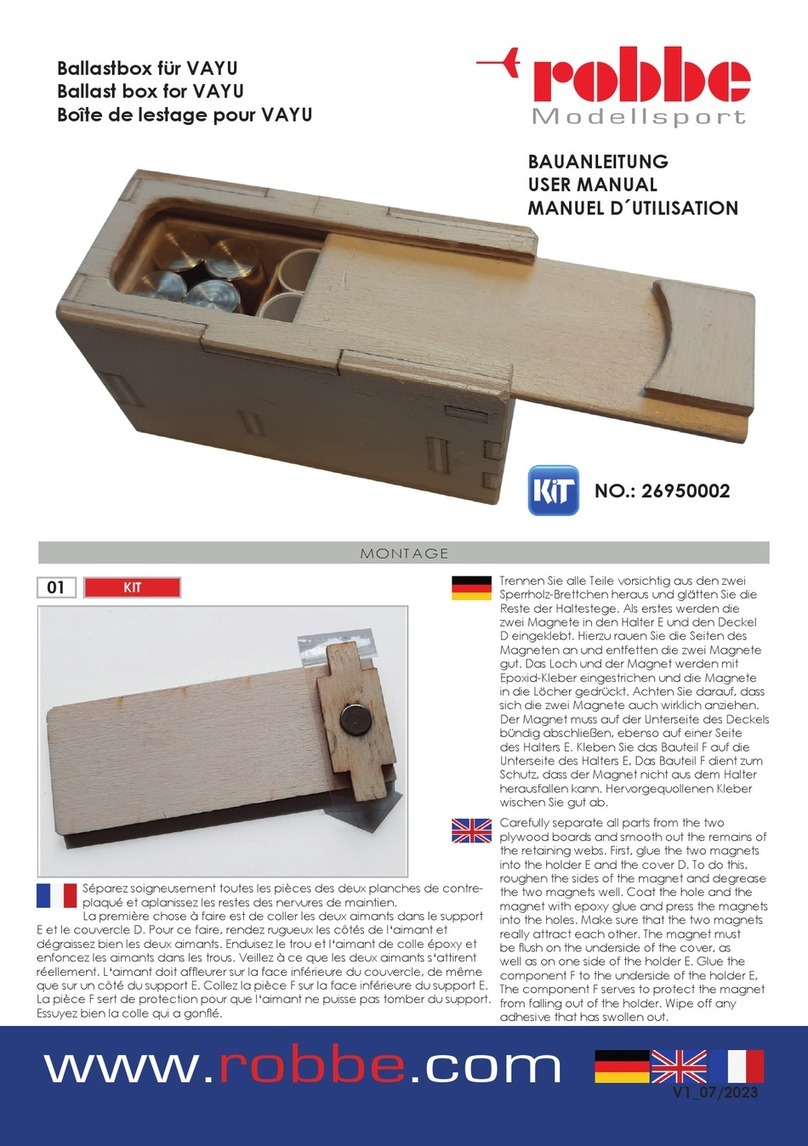
ROBBE
ROBBE 26950002 user manual
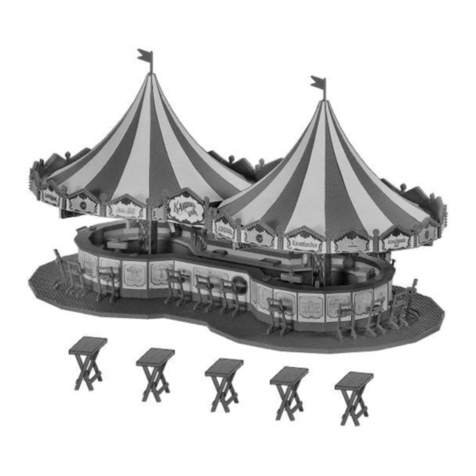
Faller
Faller Roundabout Bar manual
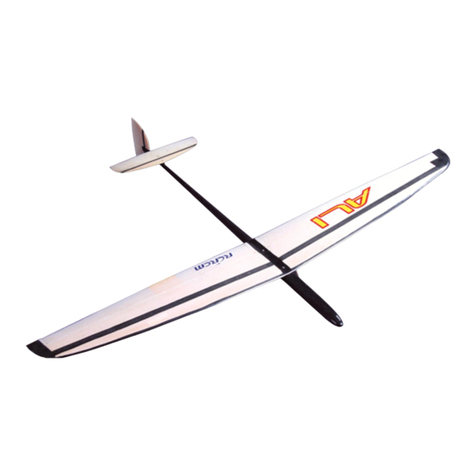
RCRCM
RCRCM DLG Ali instruction manual

LEGO
LEGO 42009 Technic Building instructions

TP Toys
TP Toys Splash and Play Happy Chef Wooden Mud... Instructions for assembly, maintenance and safe use
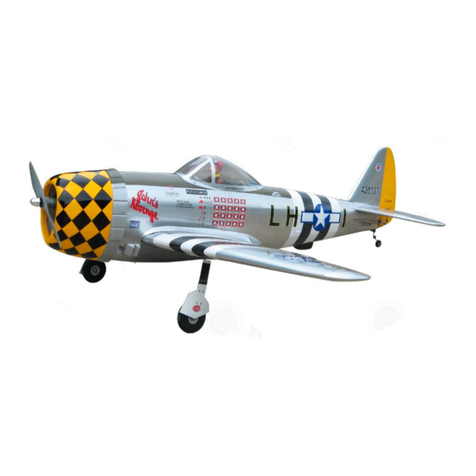
THE WORLD MODELS
THE WORLD MODELS P-47D THUNDERBOLT instruction manual
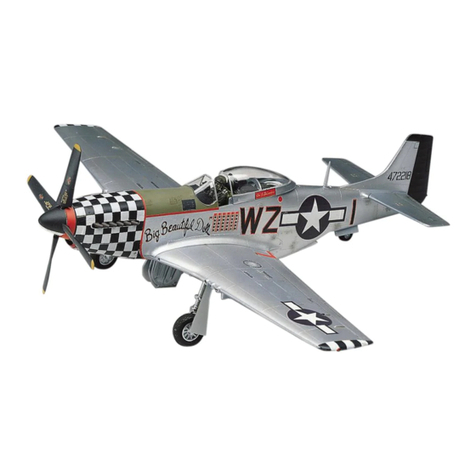
REVELL
REVELL P-51D Mustang Assembly manual

BT21
BT21 Tamagotchi instruction manual

THUNDER TIGER
THUNDER TIGER mini Titan E325 Assembly instructions
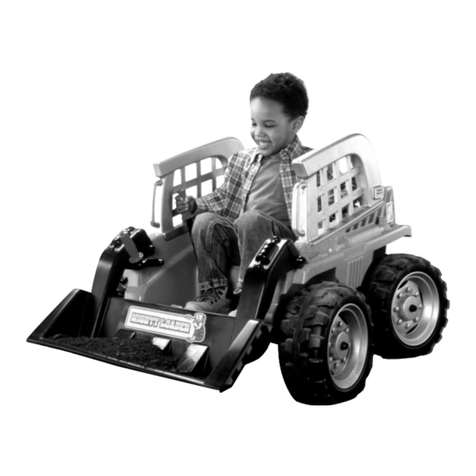
Fisher-Price
Fisher-Price MIGHTY LOADER Owner's manual with assembly instructions
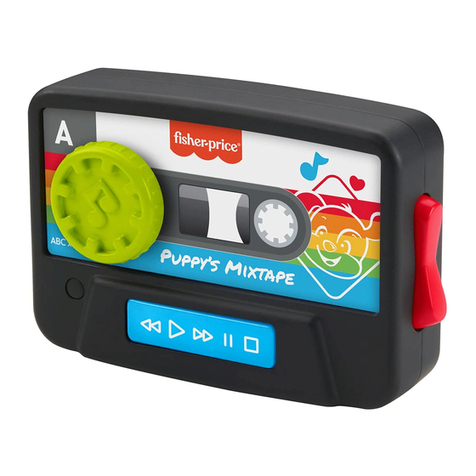
Fisher-Price
Fisher-Price Laugh&Learn Puppy's Mixtape quick start guide
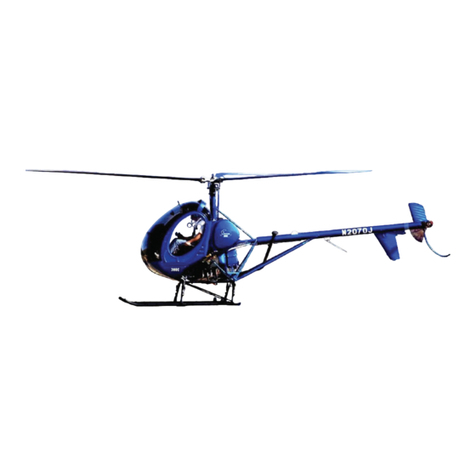
Schweizer
Schweizer S300C 269C manual
